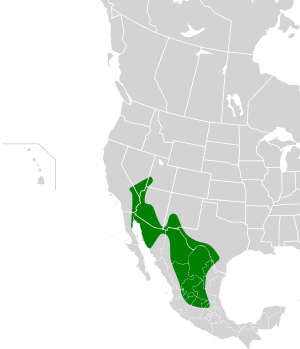Black-tailed gnatcatcher facts for kids
Quick facts for kids Black-tailed gnatcatcher |
|
|---|---|
 |
|
| Conservation status | |
| Scientific classification | |
| Genus: |
Polioptila
|
| Species: |
melanura
|
 |
|
The black-tailed gnatcatcher (Polioptila melanura) is a small bird. It eats insects. You can find it in the Sonoran Desert and Chihuahuan Desert. These deserts are in the southwestern United States and northern Mexico. This bird does not migrate. It lives in dry desert areas all year long.
Contents
About the Black-tailed Gnatcatcher's Name
An American bird expert named George Newbold Lawrence first described the black-tailed gnatcatcher in 1857. Its scientific name, melanura, means 'black-tailed'. This name comes from two Ancient Greek words. Melano- means 'black', and oura means 'tail'.
What Does the Black-tailed Gnatcatcher Look Like?
The black-tailed gnatcatcher is about 4.5 to 5 inches long. A big part of its length is its long black tail. This tail has white feathers on the outer edges. The bird's body is blue-grey. Its belly is white.
How to Tell it Apart from Other Gnatcatchers
This bird looks a lot like the Blue-gray gnatcatcher. But you can tell them apart by their tail feathers. The black-tailed gnatcatcher has more black in its tail.
Male black-tailed gnatcatchers have a black cap on their head in summer. This black cap goes down to their eyes. Females and males in winter do not have this black cap. This makes them harder to tell apart from the blue-grey gnatcatcher.
The best way to tell them apart is to look at their tail from below. The blue-grey gnatcatcher's tail is mostly white underneath. The black-tailed gnatcatcher's tail is mostly black underneath. Like other gnatcatchers, they make harsh, scolding sounds. They do this while they look for small insects and spiders. They search in desert bushes.
How Black-tailed Gnatcatchers Behave
Black-tailed gnatcatchers live in pairs all year. They protect their home area. They look for food in trees and low bushes. They eat many kinds of small insects and some spiders. Unlike the blue-grey gnatcatcher, the black-tailed gnatcatcher rarely catches insects while flying.
How Black-tailed Gnatcatchers Raise Their Young
Both male and female gnatcatchers build their nest. It is shaped like an open cup. They usually build it in low bushes, less than five feet off the ground. If there is desert mistletoe nearby, they often use it. This plant helps hide the nest well.
They build the nest from many different things. These include weeds, grass, strips of bark, spider webs, and plant fibers. They line the inside with softer materials. The female lays three to five bluish-white eggs. These eggs have small red-brown dots. Both parents take turns sitting on the eggs. The eggs hatch after about 14 days. Both parents feed the young birds. The young birds leave the nest 10 to 15 days after they hatch.
Sometimes, cowbirds lay their eggs in gnatcatcher nests. This means the gnatcatcher parents end up raising cowbird chicks. Even with this, the number of black-tailed gnatcatchers seems to be doing well.
Images for kids



